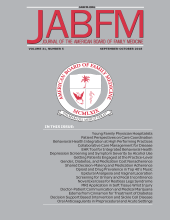Article Figures & Data
Tables
Characteristics N (%) Sex Female 8 (53) Male 7 (47) Age, years <35 5 (33) 35–49 4 (27) >50 6 (40) Race/ethnicity Asian 6 (40) Hispanic or Spanish origin 3 (20) More than 1 race/ethnicity 1 (7) White 5 (33) Physician type Practicing primary care physician 11 (73) Resident 4 (27) Use of telemedicine before onset of COVID-19 pandemic Yes 5 (33) No 10 (67) COVID-19, coronavirus 2019.
Variables Suggested Strategies for Telemedicine Visits Challenges Telemedicine leaves out some groups of patients Practice level
Offer technological assistance to all patients before their appointment
Offer telemedicine visits via whichever technology is available to the patient (smartphone, computer, or tablet)
Offer easy access to telemedicine visits that does not require downloading an application or accessing a patient portal
System level
Partner with internet and smart-device providers to provide patients with technology required to engage in telemedicine
Provide patients with maps of free Wi-Fi locations
Partner with phone companies to waive data charges for telemedicine-related servicesLack of physical examination can be problematic Develop guidelines for schedulers and physicians to guide decisions about types of visits that are appropriate for telemedicine versus in person
Establish a “virtual rooming” process immediately before physician visits during which medical assistants gather information normally obtained during in-person visits, including patient home vital signs
Teach patients to check their vital signs using home equipment (eg, blood pressure monitor, pulse oximeter, thermometer, scale) and bring measurements to telemedicine visit
Train physicians to hone diagnostic skills when seeing patients via telemedicinePhysicians lament the lack of personal connections and touch during telemedicine visits Perform telemedicine visits in private spaces to minimize interruptions
Establish rapport at the beginning of visits by smiling
Ensure that patients can see the video feed and hear the physician
Show patient your face (without face mask)*
Ensure eye contact by looking directly into the camera (not the monitor)
As time permits, make small talk as during in-person office visits
Promote the use of in-person visits for new patientsTelemedicine visits tend to be shorter than in-person visits Actively solicit additional patient concerns
Give patient ample time to raise concerns
Inform patient of expected visit duration
Consider devoting extra time to patient counselingWorkflows incorporating telemedicine visits need careful consideration to avoid physician burnout Allow physicians to individualize decisions about how telemedicine and in-person visits are scheduled to match their desired workflow
Reserve blocks of time devoted solely to telemedicine or solely to in-person visits
Support physician ability to set boundaries to prevent scheduling of telemedicine visits outside normal working hours
If offering primary care telemedicine visits after hours or on weekends, allow physicians to work in shiftsBenefits Enhance patient access to healthcare Inform all patients about the availability of telemedicine, particularly those who live far or have limited physical mobility
Offer mix of video and in-person visits for all patients amenable to telemedicine visitsDecrease patient no-show rate Call patients within 30 minutes before a scheduled telemedicine appointment to remind them of the appointment and to ensure that they are able to join the visit Many conditions can be adequately managed via telemedicine Consider telemedicine for visits focused on counseling, such as review of laboratory results and mental health care
Consider telemedicine for chronic disease management follow-up visits that do not require physical examinations, such as for diabetes management
Consider telemedicine for medication reconciliations because patients will have medication bottles availableSeeing patients’ homes and families enhances patient care Look at patients’ home environments to gain a better sense of their hobbies and living conditions
Engage and meet family members and pets when they are present↵* Requires further consideration if face masks and face shields are being used for in-person visits.






